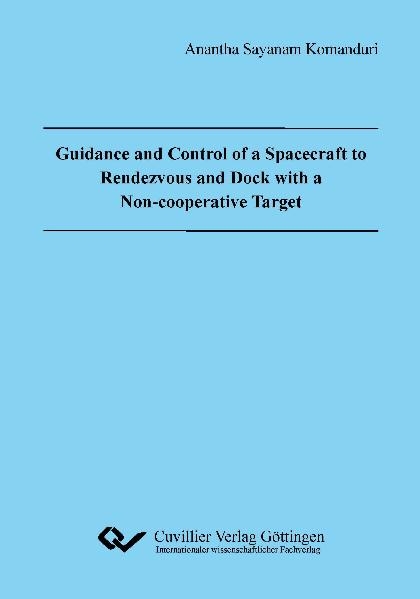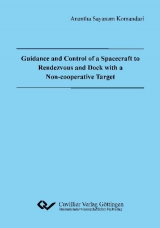Guidance and Control of a Spacecraft to Rendevous and Dock with a Non-cooperative Target
Seiten
2011
|
1., Aufl.
Cuvillier, E (Verlag)
978-3-86955-945-2 (ISBN)
Cuvillier, E (Verlag)
978-3-86955-945-2 (ISBN)
- Titel ist leider vergriffen;
keine Neuauflage - Artikel merken
Non-cooperative spacecrafts are those current or future assets in orbit which have
lost their control authority in one or more degrees of freedom and cannot convey any
information concerning their position, attitude or rates to facilitate Rendezvous and
Docking/Berthing (RVD/B) process. A growing field of study in space research is to
develop On-Orbit Servicing (OOS) technology capable of dealing with these space-
crafts, called targets, which are designed without any intention to be serviced. To
render services such as repair, refuel or removal of the target from orbit, the chaser
spacecraft should exhibit sophisticated RVD/B technology for formation fly and final
stage docking/berthing operations of the mission.
Assuming that the terminal capture operations of the target are to be performed
by a suitable manipulator system on-board chaser, this study relies upon proven
technology and outlines guidance and control methodologies to achieve rendezvous
during proximity phases. The entry gate of chaser after phasing can be defined at a
distance of about 5 km in ± V-bar direction from the target in its orbit. To account
for errors in modeling, navigation or actuation, proximity range operations from the
entry gate are decomposed into three different subphases as far range, inspection or
fly around and closer approach.
From the entry gate and along the path of the chaser two hold points are defined:
first to initiate an inspection and the second, which is close to the safe zone defined
around the target, to initiate a capture. The chaser is assumed to perform a station
keeping maneuver at the second hold point until initial conditions for the capture are
met. Possible scenarios pertaining to the behavior of the target in a circular orbit
are considered and guidance schemes for different subphases are presented using a
combination of Hill-Clohessy-Willtshire (HCW) solution, elliptical fly around, glides-
lope algorithm etc. Relative controllers both for position and attitude of the chaser
are also presented. A Linear Quadratic (LQ) controller for relative position and a
Proportional Integral Derivative (PID) controller for relative attitude with angular
velocity constraints are chosen to track down the error to achieve rendezvous and
attitude synchronization with the non-cooperative target. A comparative analysis
between different guidance trajectories for important parameters such as time, fuel
usage, minimum absolute distance and the maximum radial distance from the target
is presented. Verification of the proposed guidance and control methods is done by
applying them to two different case studies: the first study incorporating a stabilized
target in Geostationary Earth Orbit (GEO) and the second, with a spinning target
in Low Earth Orbit (LEO).
The methods presented here are general and provide a simulator to the chaser to
perform rendezvous analysis with non-cooperative targets. To achieve RVD/B, the
study proposes a careful combination of guidance solutions for different phases of
proximity operations, and for different scenario’s of the target encountered by the
chaser.
lost their control authority in one or more degrees of freedom and cannot convey any
information concerning their position, attitude or rates to facilitate Rendezvous and
Docking/Berthing (RVD/B) process. A growing field of study in space research is to
develop On-Orbit Servicing (OOS) technology capable of dealing with these space-
crafts, called targets, which are designed without any intention to be serviced. To
render services such as repair, refuel or removal of the target from orbit, the chaser
spacecraft should exhibit sophisticated RVD/B technology for formation fly and final
stage docking/berthing operations of the mission.
Assuming that the terminal capture operations of the target are to be performed
by a suitable manipulator system on-board chaser, this study relies upon proven
technology and outlines guidance and control methodologies to achieve rendezvous
during proximity phases. The entry gate of chaser after phasing can be defined at a
distance of about 5 km in ± V-bar direction from the target in its orbit. To account
for errors in modeling, navigation or actuation, proximity range operations from the
entry gate are decomposed into three different subphases as far range, inspection or
fly around and closer approach.
From the entry gate and along the path of the chaser two hold points are defined:
first to initiate an inspection and the second, which is close to the safe zone defined
around the target, to initiate a capture. The chaser is assumed to perform a station
keeping maneuver at the second hold point until initial conditions for the capture are
met. Possible scenarios pertaining to the behavior of the target in a circular orbit
are considered and guidance schemes for different subphases are presented using a
combination of Hill-Clohessy-Willtshire (HCW) solution, elliptical fly around, glides-
lope algorithm etc. Relative controllers both for position and attitude of the chaser
are also presented. A Linear Quadratic (LQ) controller for relative position and a
Proportional Integral Derivative (PID) controller for relative attitude with angular
velocity constraints are chosen to track down the error to achieve rendezvous and
attitude synchronization with the non-cooperative target. A comparative analysis
between different guidance trajectories for important parameters such as time, fuel
usage, minimum absolute distance and the maximum radial distance from the target
is presented. Verification of the proposed guidance and control methods is done by
applying them to two different case studies: the first study incorporating a stabilized
target in Geostationary Earth Orbit (GEO) and the second, with a spinning target
in Low Earth Orbit (LEO).
The methods presented here are general and provide a simulator to the chaser to
perform rendezvous analysis with non-cooperative targets. To achieve RVD/B, the
study proposes a careful combination of guidance solutions for different phases of
proximity operations, and for different scenario’s of the target encountered by the
chaser.
| Sprache | englisch |
|---|---|
| Einbandart | kartoniert |
| Themenwelt | Technik ► Elektrotechnik / Energietechnik |
| ISBN-10 | 3-86955-945-4 / 3869559454 |
| ISBN-13 | 978-3-86955-945-2 / 9783869559452 |
| Zustand | Neuware |
| Haben Sie eine Frage zum Produkt? |
Mehr entdecken
aus dem Bereich
aus dem Bereich
Wegweiser für Elektrofachkräfte
Buch | Hardcover (2024)
VDE VERLAG
CHF 67,20




